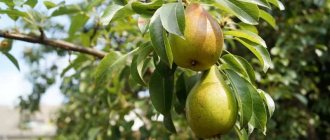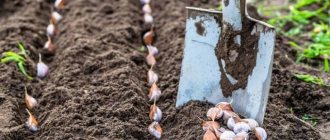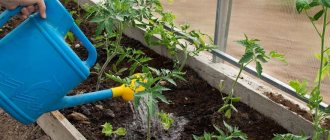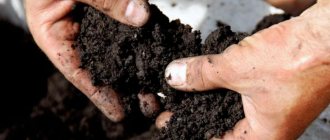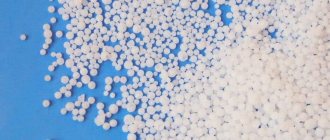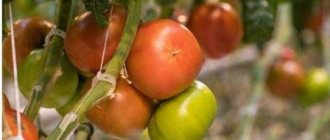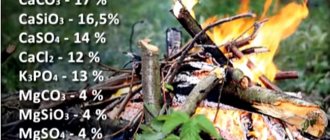Tomatoes in closed ground ripen earlier than in garden beds. In many regions of Russia with a cold climate, this is the only way to get a full harvest. Fertilizers for tomatoes in a greenhouse play a huge role in obtaining tasty, sweet, full-bodied fruits. Feeding should not be applied randomly, from time to time, but regularly, in the correct proportions, depending on the stage of growth, and sequence.
Feeding tomatoes during flowering
The tomatoes have now begun to bloom profusely, and somewhere the first cluster has already begun, somewhere else the flowering is just beginning. The picture may be different for everyone and it depends on the variety and weather conditions. But in general, now is just the time when you need to start fertilizing with root and foliar fertilizing.
Typically, the first fertilizing is carried out 10-15 days after planting seedlings in a greenhouse, which is carried out with nitrogen fertilizers. This is necessary so that the plant quickly adapts and increases its vegetative mass and root system. With the beginning of flowering, plants need less nitrogen, the emphasis is on phosphorus-potassium fertilizers.
In order for tomatoes to bloom better, they need phosphorus. And if you see that purple leaves and stems have appeared on flowering plants, it means that the plants do not have enough phosphorus, and they take it from wherever they can. This can also happen when the greenhouse is too cold. In this case, there may be a lot of phosphorus, but it is not absorbed by the plant due to the low temperature.
The problem with tomatoes is that almost all the phosphorus is obtained through fertilizing. That is, as much of this element as the plant receives, so much fruit will be produced on it later.
Yeast fertilizer for tomatoes
Yeast itself does not contain those beneficial microelements important for plant growth, such as nitrogen, potassium, phosphorus and magnesium. Yeasts are the simplest single-celled fungi. When they enter the soil, they begin to process organic residues, which, when decomposed, begin to actively release into the soil the very elements necessary for growth, that is, nitrogen and phosphorus.
Therefore, it is better to carry out the first feeding with yeast, 10-14 days after planting the seedlings in the greenhouse. Take 100 g of pressed yeast and dilute it in a small amount of warm water. Add 1-2 tbsp. l. sugar and place in a warm place for a couple of hours. As soon as the foam rises and bubbles appear, dilute the dough in 10 liters of water, the water should be warm, the yeast will not work in cold water. Then dilute 1 liter of solution in 5 liters of water and water the tomatoes at the root, 1 liter for each plant.
Read more about how to properly use yeast and make fertilizer from yeast by following the link.
Root feeding with green fertilizer
It is better to fertilize the roots with green fertilizer. To do this, fill the container ¾ full with mowed grass, nettles and fill it with regular water from a hose. The container is placed in a warm place; it is best to place it directly in the greenhouse. It’s warm there, and the carbon dioxide released during fermentation is exactly what plants need. Leave the fertilizer to infuse for 3-5 days, it should sour well so that bubbles appear on the surface and an unpleasant odor from the infusion appears.
IN
It is important to remember that fertilizing is carried out on wet soil, that is, first water the plant with clean water, only after that do root fertilizing. Afterwards the ground is watered again with clean water.
The finished infusion is diluted at the rate of 1 liter per 10 liters of water, and then 1 liter of the diluted infusion is poured under each plant.
Foliar fertilizing with boric acid
Foliar feeding in case of abundant flowering is carried out with boric acid. I wrote about feeding strawberries with boric acid during flowering. The effect of tomatoes is similar, that is, boric acid contributes to better fruit set. This means the tomato harvest will be much better.
Packets of boric acid powder (10 g each) are sold in any pharmacy and gardening stores, and in the latter it is cheaper. To adjust the working solution, take half a teaspoon (0.5 tsp) of powder and first dilute it in a small amount of hot water, for example, in a glass. Boric acid crystals dissolve very poorly in cold water. As soon as the powder has dissolved, the solution is poured into a bucket with 10 liters of water, poured into a spray bottle and sprayed on the plants, trying to get the solution onto the flowering shoots.
By the way, cucumbers and tomatoes are often grown together in a greenhouse, so don’t forget to spray the cucumber flowers at the same time.
Some gardeners recommend shaking tomato bushes slightly for better fruit set. And it is better to do this in the morning, when the pollen is as heavy as possible and it is better pollinated.
Signs of a lack or excess of nutrients in the soil
With a lack of potassium, the leaves of tomatoes become lighter and drier. It looks like a burn. Over time, the edges of the leaves begin to turn brown and curl slightly upward.
In the closet or on the windowsill: how to equip an impromptu home office
How to become a good influencer and start making money online
Record sales of printed books around the world: readers preferred paper books
A lack of phosphorus manifests itself in the form of severe darkening of the leaves. Initially they acquire a rich green color, and then the veins and upper part acquire a slight purple tint. The leaves of the plants are rolled up and pressed as close as possible to the stem.
Two signs indicate calcium deficiency. Tomato leaves may become dark in color or the tips may dry out.
Nitrogen is the only mineral that, if deficient or overabundant, can cause harm to the plant. The lack of this substance manifests itself in the form of slow growth of tomato plants, the formation of too small leaves and fruits. The leaves become weak, lethargic and acquire a yellowish tint. With an excess of nitrogen, there may be a significant thickening of the stem, cessation of the fruiting process, and active growth of stepsons. After planting in soil with undecomposed nitrogen, plants can burn completely.
It's never too late to learn new things: why it's not a shame to be an intern in adulthood
Fortune will smile on Taurus: financial horoscope for the second week of February
Joint Accounts and Legal Agreement: How to Protect Your Money in a Relationship
With a lack of magnesium, the leaves may turn yellow, but the veins remain green. Lack of iron leads to chlorosis. This disease is manifested by the formation of gray cloudy spots on healthy tomato leaves.
How to feed tomatoes during fruiting
During fruiting, potassium is extremely important for tomatoes. Its lack is immediately visible in appearance. Necrosis begins at the tips of the lower leaves, which gradually spreads along the entire perimeter. Then brown heels appear, and the leaves begin to curl, fall off, and the stem becomes limp. You understand that in this state it is unlikely that the plant will be able to bloom and bear fruit.
And even without such signs of potassium deficiency, this mineral is extremely necessary during the period of fruit formation and ripening. It is fertilizing with potassium fertilizers that makes the fruits sweet and tasty.
Wood ash for better flowering and fruit set
Ash has a rich set of minerals useful for vegetables - potassium, phosphorus, calcium, magnesium, etc. Of all fertilizers, it is an environmentally natural mineral fertilizer.
For tomatoes we make root feeding with ash infusion. This is how they prepare it. For 10 liters of water, take 1 liter of dry ash, stir the ash in the water to obtain a homogeneous substance. Leave to infuse for 2-3 hours. After this time, filter the infusion if there are large coals left. The resulting infusion is watered at the roots of the tomatoes, pouring 0.5 liters under each plant.
Fertilizing with ash increases the flower mass, plants bloom better and set fruit. It is better to carry out such fertilizing 2-3 times per season, alternating it with yeast or spraying with boric acid.
All feedings are carried out at intervals of 1.5-2 weeks, and they should alternate.
Dry ash can be scattered under the plants on damp soil, watered with water and lightly loosened. This will not only enrich the soil with useful microelements, but at the same time get rid of slugs.
Also, during the formation of ovaries, it is necessary to carry out foliar feeding. To do this, in the evening or on a cloudy day, spray an infusion of wood ash over the dry leaves. It is prepared like this: dissolve 2 cups of sifted ash in 2 liters of hot water and leave to infuse for 12 hours. Then the resulting infusion is filtered. The resulting amount of liquid is brought to 10 liters with water and the plants are sprayed with this solution.
How often should you feed
The feeding schedule for tomatoes depends on the needs of the plant at each stage of cultivation. Young bushes need fertilizer with a high nitrogen content. During the formation of buds and fruits, potassium must constantly be supplied to tomatoes.
Chaotic application of fertilizing will cause an imbalance of microelements in the soil, so it is imperative to adhere to the fertilizing schedule.
Experts recommend applying fertilizers according to the following schedule:
- at the landing stage;
- In 2 weeks;
- during a period of active growth;
- during the formation of buds;
- in the flowering phase;
- during the period of ovary formation;
- at the fruiting stage.
The diagram is approximate; in practice, it is adjusted based on the condition of the plants, determined by their appearance. Sometimes it is necessary to carry out extraordinary fertilizing.
On a note! Due to the limited volume of soil in the greenhouse, tomatoes are additionally fertilized leaf by leaf. With the greenhouse method of growing tomatoes, the total number of fertilizing is increased to 10, alternating root and foliar fertilizing with each other.
Fertilizing tomatoes with mineral (phosphorus) fertilizers
A sufficient amount of phosphorus in the soil increases plant immunity to fungal diseases and weather stress. Healthy plants bloom better, set fruit, and taste better.
Mineral phosphorus fertilizers are poorly soluble in water, and it is better to use an aqueous solution for fertilizing. Therefore, fertilizers are first diluted in a small amount of hot water, only then the volume is adjusted to the required amount of water.
Fertilizing with magnesium sulfate
Many varieties respond very well to fertilizing with magnesium sulfate. 15 g of fertilizer (approximately 0.5 tbsp) is dissolved in 10 liters of water. The resulting solution is sprayed onto tomato tops. Consumption – 1.5 l per 1 sq. m.
Superphosphate for fruit set
For active fruit set, tomatoes respond well to superphosphate. It is better to apply simple superphosphate to the soil in the fall. And for fertilizing, take double superphosphate and make an extract from it. 3 tsp. superphosphate granules, pour 0.5 liters of boiling water, leave for 6-8 hours, stir the solution periodically. Then the upper liquid part of the jar is drained. Half of the extract is diluted in 10 liters of water. The resulting solution is poured under the root, at the rate of 0.5 for each tomato.
If tomatoes are grown in a greenhouse, it is necessary to take into account that the humidity level in it is higher than in open ground. Therefore, the process of absorption of nutrients occurs faster. And in order for the plant to have time to absorb them, you need to slightly reduce their concentration of fertilizers.
Complex mineral fertilizer "Master"
Master is a complex of fertilizers with a wide variety of microelements. Each species contains a specific set of them, which is suitable for a specific plant at different stages of its development.
Fertilizers are very easy to use; you just need to determine what microelements the plant needs.
Feeding tomatoes during fruiting is determined by the formula (nitrogen-phosphorus-potassium) NPK 15-3-30, which means:
- 15% - nitrogen,
- 3% phosphorus
- 30% potassium.
Nitrogen during fruiting is not so important, but it is necessary, since all efforts are devoted to the development of the fruits, but the stems are weakened and thinner towards the top, which indicates a lack of nitrogen, and potassium is necessary for filling the fruits.
But using this fertilizer alone, the effect will be small, since calcium is also needed, it is necessary to increase metabolism in the plant so that other microelements can be better absorbed. Therefore, the next day after feeding with “Master”, fertilize with Calzenite. These feedings are carried out for 6 days, according to the scheme
- Day 1 – Master NPK 15-3-30,
- 2nd day - Calzenite,
- Day 3 – Master,
- 4th day - Calzenite,
- Day 5 – Master,
- Day 6 - Calzenite.
Calzenite cannot be mixed with other complex fertilizers, otherwise an insoluble precipitate will form, that is, all the properties of calcium are lost.
Needs of greenhouse tomatoes
Like all fruit-bearing plants, tomatoes in a greenhouse need nitrogen, potassium and phosphorus fertilizers. They are used during various periods of the growing season and fruit filling. If you skip one stage, then it is very difficult to increase the number of ovaries, increase the green mass or restore the root system.
Therefore, all stages need to be completed one by one, monitoring the appearance of the plants, which can tell an experienced gardener a lot, but it will be difficult for beginners to notice that something is wrong the first time.
Greenhouse plants are more susceptible to diseases due to a lack of microelements. Do not ignore the advice regarding foliar spraying. This will protect the tomato bushes from fungal diseases and prolong the fruiting period.
Video: Full cycle of growing tomatoes in a greenhouse
The fungus begins its activity in the warm season, most often in mid-summer. At this time there is a peak incidence of tomatoes. If measures are not taken, by autumn there will be no healthy bushes and fruits left. How to feed tomatoes in a greenhouse in July to avoid spoilage of fruits and herbs, read below.
The acidity of greenhouse soil is problem number one. How to fertilize tomatoes in a greenhouse so that the quality of the soil does not change and there is no need to completely change the soil due to a bacterial or fungal disease?
Tomatoes do not like being next to cucumbers because they have different needs for watering and air humidity. Growing both crops in one greenhouse means not getting a single good harvest.
Organic fertilizers for feeding tomatoes in a greenhouse
Organic fertilizers are rich in nitrogen. Nitrogen is an essential element for plant development. It supports metabolism, is found in all plant cells, in proteins, amino acids, chlorophyll, plant hormones, and vitamins. It plays a huge role in plant nutrition. Its deficiency affects vital functions.
It is especially essential for young plants when leaves and stems are actively growing. But as they grow, the need for nitrogen decreases. Therefore, the first feeding of young plants is carried out with organic fertilizers. To do this, use any liquid organic fertilizers:
- slurry,
- infusion of chicken manure,
- herbal infusion.
Using liquid organic fertilizers, they are diluted at the rate of 1 liter of infusion per bucket of water (10 liters) and watered 1 liter for each plant.
As an alternative to organic fertilizers, you can use mineral fertilizers (urea, ammonium nitrate, ammonium sulfate), since they contain a sufficient amount of nitrogen. These fertilizers are diluted with 1 tbsp. l. (10 g) per bucket of water, consumption rate 20 g (2 tbsp.) per 1 sq. m.
Active fruiting period
Fertilizing at this stage will help increase productivity, extend the period of fruit formation and improve the taste of tomatoes. Organic and mineral substances can be used as fertilizer.
To prepare a complex fertilizer, you need to add 40 g of potassium sulfate, ammonium nitrate and superphosphate to a bucket of water. During fruiting of tomatoes, nettle infusion can be used as fertilizer. It contains potassium, iron and magnesium.
To do this, you need to chop 5 kg of nettles and fill it with 10 liters of clean water. Place in a container under a press and leave for 2 weeks. This fertilizer can be used together with humus or infusion of manure.
Ammonia - as a fertilizer for tomatoes
Ammonia has proven itself well in cases of nitrogen deficiency, as an ambulance. The advantage of using it is that nitrogen is here in an easily digestible form.
Dilute 2-3 tbsp. l. ammonia per 10 liters of water, watering at least 1 liter at the root for each bush. They feed again after 2-3 weeks, and this is enough to quickly cope with the lack of nitrogen.
During the flowering period
The first fertilizing from the day the seedlings are planted in the soil should be introduced after about 3 weeks. It is during this period that the active flowering period of tomatoes begins. It is necessary to add fertilizing in the form of phosphorus, potassium and nitrogen.
You can use organic or mineral fertilizers. The simultaneous application of mineral and organic substances also shows quite high effectiveness.
An infusion of rotted manure or bird droppings is considered good organic matter. If you decide to use manure, then you should give preference to mullein. To prepare the fertilizer, you need to mix 1 liter of manure into a bucket of water. You need to water directly at the root. To prepare the fertilizer, bird droppings should be diluted with clean water in a ratio of 1:20.
Ignoring or achieving a goal: the difference between workaholism and success
Deterioration in the quality of relationships: the dangers of speculation about colleagues
How to achieve a balance of work and rest and what you need to know about this phenomenon
Minerals are contained in the ash. It can be used as a fertilizer. However, only the combustion product of natural wood is suitable. Ash should be diluted in a proportion of 4 liter jars per 100 liters of water. Mix thoroughly and add the resulting ash solution to the root.
Feeding tomatoes with hydrogen peroxide in a greenhouse
Hydrogen peroxide is a good fertilizer for tomatoes. The results of its use can be seen in just a few days. Peroxide improves the structure of the soil and disinfects it. When used correctly, the product does not have a negative effect on either the fruit or the soil.
To prevent tomato diseases, foliar feeding is carried out by spraying the bushes. Dilute 10 tbsp. l. hydrogen peroxide per 10 liters of water, repeated treatments are carried out after 2 weeks. The treatment is carried out with a fine spray so that the leaves are treated on all sides. Treatment is carried out in the evening or during the day in cloudy weather, or in the absence of rain for tomatoes growing in open ground.
To treat the soil, apply root watering once a week, dissolving 50 ml of peroxide in a bucket of water. During the procedure, avoid getting the solution on the leaves. Before watering, first water the soil with clean water and then with the prepared solution. It is important that the soil is spilled at least 10 cm, so one plant will require at least 1 liter of solution.
Table of phased application of fertilizers
This handy sign will help you find the answer to the question of when, what and how many times you can feed tomatoes in open ground or a greenhouse.
| Plant development stage | Month | How many times (depending on the condition of the tomatoes) | What substances are needed (in descending order of need) | Drugs |
| When planting in the ground | May | 1 | potassium nitrogen phosphorus | OMU “For peppers, tomatoes, eggplants” “Senior Tomato” “Spring-summer universal” “Giant” Ammofoska Ash Humus |
| 2 weeks after landing | May June | 1 — 2 | potassium phosphorus nitrogen + trace elements | Superphosphate Urea Ammonium nitrate Ash Manure Humate |
| During the period of growth | May June | 1 — 2 | phosphorus nitrogen | Nitroammophoska Iodine solution Ash Superphosphate |
| During flowering | may June July | 2 — 3 | phosphorus potassium | “Kemira Lux” “Universal” “Solution” “Senior Tomato” Herbal infusion |
| During fruit set | June July | 2 — 3 | phosphorus potassium | “Sudarushka” “Ovary” “Tamaton” Ammofoska Zola |
| During the fruiting period | June July August | 2 — 3 | boron manganese iodine phosphorus potassium | Boric acid Iodine solution Saline solution Ash Mullein Solution Potassium sulfate For quick filling: “Dripper” “Estrel” “Sweet” “Benefit” Potassium monophosphate |
Iodine for feeding tomatoes
Iodine is no less important for normal growth and fruiting, as it accelerates the ripening of fruits and increases the quantity on the bushes. Its great merit is that it has an antimicrobial effect. By regularly spraying tomato bushes with iodine solution, you can prevent the development of late blight on tomatoes. In addition, thanks to the specific smell, insect pests will not fly close to the greenhouse.
To obtain a good harvest, foliar feeding is carried out with a solution of milk (it is better to take fatty milk) and iodine. Pour 1 glass of milk into a liter jar, bring the volume to 1 liter with water, and add 4-5 drops of iodine. The composition is stirred and sprayed on the leaves. It is best to carry out treatment in the evening after sunset, early in the morning or in cloudy weather. Follow the dosage of iodine, otherwise you can burn the leaves.
Watering tomatoes with iodine is carried out 3-4 times per season. The first time is carried out after planting the seedlings in a permanent place in the greenhouse.
In this case, such treatment will be very useful, because after transplantation the plant experiences stress, which impairs resistance to various infections. Watering a tomato bush with this composition will increase immunity and protect against fungal infections.
The second treatment is carried out when the ovaries begin to set. Subsequent treatments are carried out when the fruits begin to fill.
What elements do tomatoes need, features of their application?
The fertilizing requirements of tomatoes are average. The agronorm of the crop, that is, the ratio between the main macroelements - nitrogen (N), phosphorus (P) and potassium (K) is 36:19:45.
When applying fertilizers for tomatoes in a greenhouse, you need to take into account that the plants:
- love phosphorus (compared to other crops);
- need moderate doses of potassium;
- Nitrogen must be added, but carefully.
The latter means that it is impossible to do without nitrates - the element is a building material for the cells of all vegetative organs, including roots and fruits.
But the need of tomatoes for it depends on the stage of development:
- Vegetative - the bush grows stems and leaves that can support and feed flowers, ovaries, and ensure the filling and ripening of tomatoes. Requires high doses of nitrogen.
- Generative (fruiting). It occurs simultaneously with the protrusion of the primordium of the second flower raceme. The need for the element drops to a minimum, but remains. If you do not give tomatoes nitrogen at all, the growth and development of the entire plant, including the fruits, will stop. There will simply be nothing to build cells from after the leaves have depleted their reserves.
Overfeeding tomatoes with nitrogen leads to fattening of the bush - an increase in vegetative mass to the detriment of fruiting. If you stop giving the crop an element after entering the generative phase, early cropping of determinate varieties will begin, indeterminate varieties will experience starvation, and the yield will decrease significantly.
The remaining macroelements are no less important when applying fertilizers for tomatoes in greenhouses; there is simply no doubt about the advisability of applying them even among novice gardeners:
- potassium increases the sugar content of tomatoes, especially needed during flowering and fruit formation;
- phosphorus is important in the initial stages of plant development - it is responsible for root formation, transfers tomatoes from the vegetative stage to the generative stage, subsequently gives the plant energy, and participates in photosynthesis.
These are just the basic functions of potassium and phosphorus; in fact, there are more of them.
Calcium fertilizers for tomatoes in a greenhouse
Tomatoes vitally need calcium, which promotes the absorption of other elements.
It is Ca deficiency that leads to blossom end rot of tomatoes.
Gardeners should be aware that even with sufficient or excess calcium in the soil, its absorption can be blocked by phosphorus, magnesium and potassium.
In order for tomatoes to absorb calcium well, you must strictly adhere to the rules:
- Make double feedings. First they give calcium, then, after 2-3 days, the rest of the fertilizers.
- The Ca:K ratio should be 7:10. This rule is mandatory, and not invented by agronomists to complicate the life of gardeners.
- Calcium absorption is facilitated by combined application with nitrogen.
Typically, tomatoes rarely suffer from a lack of microelements if the bushes are fed with specialized fertilizers. The manufacturer not only included them in the composition of the drug, but also took care of the correct proportions.
Additional may be required:
- boron - prevents flowers or ovaries from falling off;
- copper – a deficiency of this microelement provokes the development of late blight.
Greenhouse preparation
It is necessary to plant tomatoes only in a pre-prepared greenhouse. The specifics of preparation directly depend on the timing of disembarkation. If you plan to plant seedlings in central Russia in a film greenhouse in early May, then it is advisable to cover it with 2 layers of film. If glass or polycarbonate is used as a coating, then additional insulation is not necessary.
When grown in greenhouses, tomatoes require large amounts of air. Therefore, they should have vents not only on the sides, but also on the top. Without proper ventilation, caring for tomatoes will be incomplete.
To prevent possible infection with fungal diseases, experts recommend changing the soil annually. If this is not possible, then it is advisable to remove a layer 10 cm thick. Afterwards, the soil should be sprayed with a boiling solution of copper (II) sulfate. This is necessary if tomatoes or cucumbers were grown in a greenhouse the previous year. Disinfection of the greenhouse is a mandatory annual procedure.
If the soil in the greenhouse is not highly fertile, then it is advisable to apply organic fertilizers in the fall. Rotted manure and humus have proven themselves best. A good fertilizer is mulch that has spent the season. If the soils are highly acidic, then for each m2 add 600 g of lime or dolomite flour and 6 kg of organic matter. Manure, compost, and bird droppings are used.
Comment! In areas with good yields, autumn fertilizing is not necessary.
In the spring, when digging on “rich” soils, it is recommended to add 3 kg of rotted manure, humus, and sawdust per m2. On low-yielding soils, the amount of recommended humus increases to 7 kg. At the same time, it is recommended to apply peat or wood ash: 1 cup of fertilizer is required for each m2.
On loamy and clayey soils, it is additionally required to add 1 tbsp of potassium sulfate, 2 tbsp of nitrogen fertilizers and 1 cup of dolomite flour or ash as a deoxidizer per m2.
But if in the previous year a lot of organic fertilizers were added to the soil, then the advice on fertilizing the soil before planting tomatoes in a greenhouse changes. Manure and humus should be abandoned. Their application will cause excess nitrogen content in the soil.
The first time after planting - how to help the plant strengthen
The primary phase of development in the Solanaceae family is very significant, since during this period the root system is strengthened. Proper feeding stimulates the growth of the bush and will help it adapt to a new environment. The seedlings get used to the soil in the first 10–14 days; after this period, you can begin the first application of fertilizers. Nitrogen-containing compounds will provide a powerful impetus for growth.
Soil moisture in a greenhouse is higher than in an open environment. Nutrients will be absorbed much more actively. It is necessary to make the fertilizer less concentrated, this will contribute to the successful absorption of all elements.
For the first feeding, gardeners use a mixture of mullein. It includes:
- mullein (1 l);
- ash (0.5 cup);
- superphosphate (1.5 tablespoons);
- water (10 l).
The solution is consumed in the amount of 0.5 liters per seedling bush. Before applying this liquid, be sure to water the soil with plenty of water, otherwise direct contact with the fertilizer will lead to burning of the roots.
Feeding according to folk recipes also gives good results. Agronomists fertilize tomatoes with Green Tea tincture, which is prepared from the following elements:
- water (50 l);
- chopped grass (weed, nettle, lawn greens) – 5 kg;
- mullein (1 bucket);
- ash (1 cup).
The ingredients are prepared in a large vessel, such as a barrel, which is covered with film. It is then left in a sunny place to ferment. The solution is prepared for two weeks, and it needs to be stirred daily to get rid of air bubbles. After this time, the infusion is diluted with water, bringing the total volume to 100 liters. It is necessary to use “Green tea” (2 liters per bush) after abundant watering with running water.
Chicken droppings have a good effect on berry development. The solution is prepared from a third of a bucket of dry droppings and water. You need to leave it for about a week, stirring regularly. The fermented slurry is diluted with water (1 liter of fertilizer per bucket of water). Fertilizing should be applied in small portions: one liter of tincture is poured under each seedling bush, avoiding contact with the leaves. The second feeding is carried out ten days after the first with the same solutions.
Mineral mixtures - names, successful combinations
The most affordable and economical fertilizers for tomatoes in a greenhouse are mineral mixtures. There are single-component, two-component and complex.
In greenhouses they are trying to grow hybrid varieties of tomatoes that require more phosphorus-potassium nutrition. In this case, organic matter alone may not be enough and the tomato pulp will change consistency. If during the fruiting period the plant lacks potassium, the pulp will look something like this.
Hard white veins will appear and chewing such a vegetable will not be easy. It's not so much about potassium, but about phosphorus, without which the root system gradually dries out and cannot absorb potassium, which affects the filling of fruits. Therefore, special attention should be paid to the amount of potassium and phosphorus.
Tomato feeding in July in the greenhouse is carried out:
- superphosphates – phosphorus content 26% ;
- potassium magnesia – potassium content 26%, magnesium – 18% ;
- complex phosphorus-potassium fertilizers - “Autumn”, “AVA”.
Dosages are indicated in the instructions. It is recommended to strictly adhere to them.
The summer-autumn period is exactly the case when it makes sense to add organic matter to mineral fertilizers, or vice versa. The record holders for phosphorus and potassium content are wood ash and bone meal. To prevent a lack of potassium and phosphorus, you need to add one of the substances to the soil during flowering.
They do not spoil the soil, and the benefits to the plants will be tangible. In addition, they contain the necessary calcium to improve the taste of tomatoes and form the consistency of the pulp. This element has been undeservedly transferred to the category of microelements. It is required much more than other microfertilizers.
Folk remedies
If you have the time and desire to make infusions and decoctions, then tomatoes can be fed in a greenhouse using available and inexpensive products: weeds, vegetable peelings, ash, iodine, ammonia.
Green fertilizer (vonilovka)
A fertilizer popular among gardeners that does not require material costs. To prepare it, you only need a barrel of the required volume (20, 40 or 200 l). It is placed in a greenhouse or in a sunny spot, in an area far from housing, since during fermentation an unpleasant odor spreads from the raw materials.
The container is filled to the top with any weedy chopped grass and vegetable peelings, without compacting it. Sometimes a few glasses of ash and a couple of shovels of fresh manure are added to the barrel to enhance fermentation.
Fill the mass with water and leave to ferment for several days. The contents of the barrel must be stirred daily. The time it takes for the fertilizer to be ready depends on the temperature; the higher it is, the faster the grass will ferment. Readiness is determined by the smell - when it becomes unbearably smelly, the “vonilovka” is ready.
On a note. You can remove the unpleasant odor from the liquid by adding Baikal or a bottle of valerian to the infusion.
For work, green fertilizer is diluted with water 10 times.
Boric acid
Fertilizing with boron helps tomatoes set more fruits and makes them larger. Spraying the plant at the stage of flowering and fruit set is effective. Dissolve 1 g of boric acid powder in 1 liter of water.
Boric acid for tomatoes, a super product for increasing yield: video
Iodine
Pharmacy tincture of iodine is used not only as a top dressing, but also as a prevention of fungal diseases. To irrigate tomato tops, take 10 drops of 5% iodine tincture per 10 liters of water.
Egg shell infusion
You can compensate for the lack of calcium and protect tomatoes from blossom end rot using a safe infusion on eggshells. The product, dried and crushed into powder, is poured with cold water and left for 2-3 days, after which it is poured over the tomatoes. You can also use water from boiling eggs. There is no need to be afraid of an overdose.
Ammonia
Ammonia, or ammonia, delivers nitrogen to tomatoes in the most accessible form for absorption. Spraying plants with ammonia solution is used as an “ambulance” in case of acute shortage of the element. A bonus is the strong smell of fertilizer, which repels pests.
For 10 liters of water you will need 1 tbsp. l. ammonia 10%.
Ash
A source of potassium and microelements for the plant. The most useful product is the combustion of birch and oak firewood, sunflower stems, and cereal straw.
Important! It is prohibited to use ash from burning polyethylene, painted boards, or synthetic rags.
For fertilizing, only fresh ash or ashes stored in a tightly closed container are used. If the ash has been exposed to moisture, there will be no benefit from the fertilizer.
The infusion is prepared from 400 g of ash, poured with hot water (10 l), but not boiling water. Useful substances pass into solution in 2 days. Before use, the liquid must be strained.
After landing
In the period from 3 to 5 days after planting the growing bushes in the greenhouse (usually the first days of June), they need to be fed with complex fertilizer, which contains:
- phosphorus;
- nitrogen;
- potassium.
At the same time, the main thing is not to overdo it with nitrogen, since the leaves will grow too actively, and on the contrary, there will be fewer fruits.
The climate in the greenhouse is more humid than in open ground, so the plants will absorb nutrients very quickly.
To ensure that microelements have time to be absorbed, it is better to reduce the concentration of fertilizers . This option is most optimal: 3 tsp. dilute nitrophoska, half a liter of mullein in 9 liters of water, pour 1 liter of fertilizer under the root of each bush.
Diseases of greenhouse plants
Every fruiting season, gardeners are faced with a problem and question: tomatoes grow poorly in a greenhouse - what to feed them with. If everything has been done correctly before, according to schedule, but the plants look unwell (some of them), then the disease has begun. Most likely fungal. It is necessary to inspect the bushes and urgently remove the damaged ones before they infect all the others.
Healthy plants need to be sprayed with a solution of microelements on the outside and inside of the leaf plate.
Feeding tomatoes in a greenhouse with microelements will boost the plants’ immunity, and they will cope with the disease. If 2 - 3 bushes are affected, you need to urgently take action and treat the fungus with chemicals.
To prevent the spread of diseases in the greenhouse, you need to:
- monitor soil acidity;
- add organic matter;
- use biological products containing beneficial bacteria;
- burn plant residues after harvesting.
Some gardeners deliberately leave fresh manure on the surface of the soil so that ammonia disinfects the walls of the greenhouse, but this is a dubious method.
For some fungal diseases there is no special fungicide, so the only option is to buy resistant hybrids and monitor the plant’s immunity - regularly fertilize the tomatoes in the greenhouse.
Fruit ovary
During fruit set, tomato tops are sprayed with an ash solution . Solution recipe:
- Dilute 2 cups of ash in 2 liters of water (preferably hot);
- leave for 48 hours;
- strain the infusion to remove sediment, and then dilute it again in water - up to a volume of 10 liters.
It is advisable to process plants in the evening or on cloudy days, when there is no direct sunlight.
Attention! When processing ash, tomato leaves must be dry.

